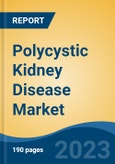Speak directly to the analyst to clarify any post sales queries you may have.
10% Free customizationThis report comes with 10% free customization, enabling you to add data that meets your specific business needs.
Key Market Drivers
Increasing Prevalence of Polycystic Kidney Disease (PKD)
The rising incidence of PKD worldwide is a major growth catalyst for the market. As a hereditary condition, PKD has seen growing diagnosis rates due to enhanced screening and genetic testing. Autosomal dominant PKD (ADPKD) affects approximately 1 in every 400 to 1,000 people, while autosomal recessive PKD (ARPKD) occurs in 1 in 20,000 to 40,000 individuals. With healthcare systems adopting more robust diagnostic practices, particularly among individuals with a family history of the disease, the patient pool is expanding. Increased awareness among clinicians and the general public has led to earlier detection and intervention, promoting demand for both supportive and disease-modifying therapies. As the affected population grows, pharmaceutical investment in PKD-focused research and treatment innovation is also accelerating.Key Market Challenges
High Treatment Costs
The high cost associated with PKD treatment continues to hinder broader access and adoption of advanced therapies. Management of PKD often requires lifelong monitoring, imaging, nephrology consultations, and eventually renal replacement therapies such as dialysis or kidney transplantation in advanced cases. Limited availability of approved and cost-effective medications further compounds the financial burden on patients. Targeted drugs that are in clinical development or recently approved tend to be expensive, making them inaccessible to many, particularly in low-resource settings. Additionally, the long-term costs of managing disease progression and complications place pressure on both patients and healthcare systems, posing a substantial challenge to the market's growth and equitable treatment access.Key Market Trends
Advancements in Genetic Research
Ongoing progress in genetic research is significantly influencing the PKD treatment landscape. Identification of mutations in genes such as PKD1 and PKD2 has facilitated the development of personalized treatment strategies and innovative therapies targeting the molecular mechanisms driving cyst formation. Gene-editing technologies and pharmacogenomics are enabling the design of more effective and potentially curative interventions. Furthermore, the discovery of reliable biomarkers is supporting early diagnosis, disease monitoring, and patient stratification for clinical trials. These advancements are streamlining drug development and paving the way for precision medicine in PKD care. Collaborations among geneticists, pharmaceutical companies, and advocacy groups are accelerating these efforts, increasing the pace at which research translates into clinical practice and market offerings.Key Players Profiled in this Polycystic Kidney Disease Market Report
- Otsuka Pharmaceuticals
- Camber Pharmaceuticals
- Apotex Corp
- Ascend Laboratories
- Par Pharmaceuticals
- Teva Pharmaceutical Industries
- Merck KGA
- Accord Healthcare
- Pfizer Inc.
- PD-Rx Pharmaceuticals, Inc
Report Scope:
In this report, the Global Polycystic Kidney Disease Market has been segmented into the following categories, in addition to the industry trends which have also been detailed below:Global Polycystic Kidney Disease Market, by Type:
- Autosomal dominant polycystic kidney disease (ADPKD)
- Autosomal recessive polycystic kidney disease (ARPKD)
- Others
Global Polycystic Kidney Disease Market, by Treatment Type:
- Diagnosis
- Drug/Therapy
Global Polycystic Kidney Disease Market, by End User:
- Hospitals & Clinics
- Ambulatory Care Centers
- Others
Global Polycystic Kidney Disease Market, by Region:
- North America
- United States
- Canada
- Mexico
- Europe
- France
- United Kingdom
- Italy
- Germany
- Spain
- Asia-Pacific
- China
- India
- Japan
- Australia
- South Korea
- South America
- Brazil
- Argentina
- Colombia
- Middle East & Africa
- South Africa
- Saudi Arabia
- UAE
Competitive Landscape
Company Profiles: Detailed analysis of the major companies present in the Global Polycystic Kidney Disease Market.Available Customizations:
With the given market data, the publisher offers customizations according to a company's specific needs. The following customization options are available for the report.Company Information
- Detailed analysis and profiling of additional market players (up to five).
This product will be delivered within 1-3 business days.
Table of Contents
Companies Mentioned
The leading companies profiled in this Polycystic Kidney Disease market report include:- Otsuka Pharmaceuticals
- Camber Pharmaceuticals
- Apotex Corp
- Ascend Laboratories
- Par Pharmaceuticals
- Teva Pharmaceutical Industries
- Merck KGA
- Accord Healthcare
- Pfizer Inc.
- PD-Rx Pharmaceuticals, Inc
Table Information
| Report Attribute | Details |
|---|---|
| No. of Pages | 185 |
| Published | May 2025 |
| Forecast Period | 2024 - 2030 |
| Estimated Market Value ( USD | $ 502.39 Million |
| Forecasted Market Value ( USD | $ 758.69 Million |
| Compound Annual Growth Rate | 7.1% |
| Regions Covered | Global |
| No. of Companies Mentioned | 11 |









